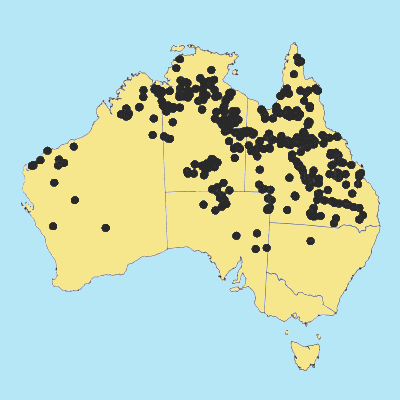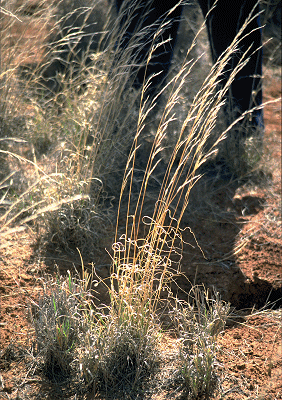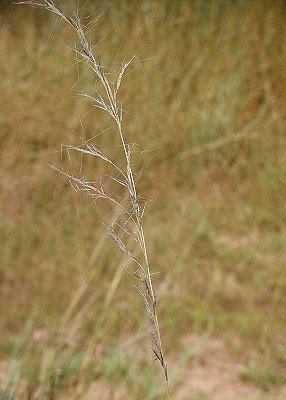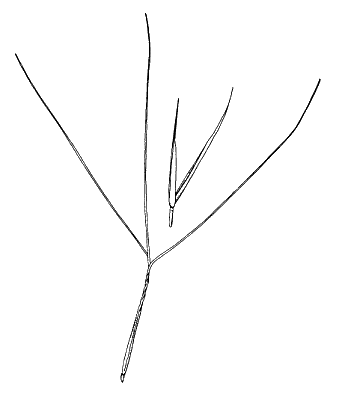Aristida latifolia Domin. Biblioth.
Bot. 85: 339 (1915).
Classification. (GPWG 2001) : Subfamily Aristidoideae.
Aristideae.
Type of Basionym or
Protologue Information: ST: K. Domin s.n., Mar 1910, Australia: Queensland: Hughenden (L (2 sheets), PR).
ST: Domin s.n., Feb 1910, Australia:
Queensland: Savannenwäder am Walsh River
nordlich von Chillagoe ST:
Domin s.n., Feb 1910, Australia:
Queensland; Grasflächen der Roling Downs bei Winton.
Key references
(books and floras): [1952] C.A.Gardner, Flora of Western Australia 1
Gramineae (169), [1981] M.Lazarides in J.Jessop (ed)., Flora of
Central Australia (451), [2002] D.Sharp & B.K.Simon, AusGrass,
Grasses of Australia, [2006] J.Jessop, G.R.M.Dashorst, F.M.James, Grasses
of South Australia (325), [2008] S.W.L.Jacobs, R.D.B.Walley &
D.J.B.Wheeler, Grasses of New South Wales (129).
Illustrations:
[1952] C.A.Gardner, Flora of Western Australia 1 Gramineae (167,
Pl. 49), [1983] J.C.Tothill & J.B.Hacker, Grasses of Southern Queensland
(104(12)), [2005] K.Mallet (ed.), Flora of Australia 44B: Poaceae 3
(Fig. 18A), [2006] J.Jessop, G.R.M.Dashorst, F.M.James, Grasses of South
Australia (325, Fig. 258), [2008]
S.W.L.Jacobs, R.D.B.Whalley & D.J.B.Wheeler, Grasses of New South Wales,
4th edn (129).
Derivation: L. latus,
broad; folium, leaf. Leaf-blades broad or relatively broad with respect
to related species.
Habit. Perennial.
Culms 20–131 cm tall, 2 -noded. Mid-culm internodes glabrous. Mid-culm nodes
glabrous. Lateral branches simple or sparsely branched. Leaf-sheaths
scaberulous, glabrous on surface. Ligule a fringe of hairs, 0.5–1 mm long.
Leaf-blades curled, flat or conduplicate or involute or convolute, 35–70 cm
long, 2–4.5 mm wide. Leaf-blade surface scaberulous.
Inflorescence.
Inflorescence compound, a panicle. Panicle linear, 8–69 cm long, 3–3.5 cm wide.
Spikelets.
Spikelets pedicelled. Fertile spikelets 1-flowered, comprising 1 fertile
floret(s), without rachilla extension, lanceolate, terete, 8–17 mm long.
Glumes. Glumes
similar, thinner than fertile lemma. Lower glume lanceolate, membranous,
keeled, 1-keeled, 1 -nerved. Lower glume apex awned. Upper glume lanceolate,
8–17 mm long, membranous, keeled, 1-keeled, 1 -nerved. Upper glume surface
asperulous or scabrous. Upper glume apex entire or erose, awned.
Florets.
Fertile lemma 8–11 mm long, without keel, 3 -nerved. Lemma apex awned, 3
-awned. Median (principal) awn 18–59 mm long overall, with a straight or
slightly twisted column or with a twisted column. Column 1–9 mm long. Lateral
lemma awns present. Palea without keels. Anthers 3. Grain 5–7.5 mm long.
Continental
Distribution: Australasia.
Australian
Distribution: Western Australia, Northern Territory, South Australia,
Queensland, New South Wales.
Western Australia: Gardner,
Fitzgerald, Hall. Northern Territory: Darwin & Gulf, Victoria River,
Barkly Tableland, Central Australia South. South Australia: North-western, Lake Eyre, Gairdner-Torrens Basin, Eastern. Queensland:
Burke, Cook, Darling Downs, Gregory North,
Leichhardt, Maranoa, Mitchell, North Kennedy, Port Curtis, South Kennedy,
Warrego, Gregory South. New South
Wales: North-Western Plains.
Notes.
A. latifolia differs from A. macroclada and A. psammophila
by its subequal glumes and from A. schultzii and A. warburgii by
the 1-nerved lower glume. There is some variability in the development of the
lemma column, which is sometimes reduced to 1–2 spirals.
All mainland states in cracking clay soils, except Victoria. Mainly tropical. A major problem
to the pastoral industry on the Mitchell grass (Astrebla spp) grasslands
(Filet 1990). Acacia, brigalow (Acacia harpophylla), blue-grass
downs (Dichanthium spp), Eucalyptus, gidgee (Acacia cambagei),
Mitchell grass (Astrebla spp), Eremophila and Melaleuca
communities on clays, redearths, sandy and alluvial soils. Flowering and
fruiting all year.





